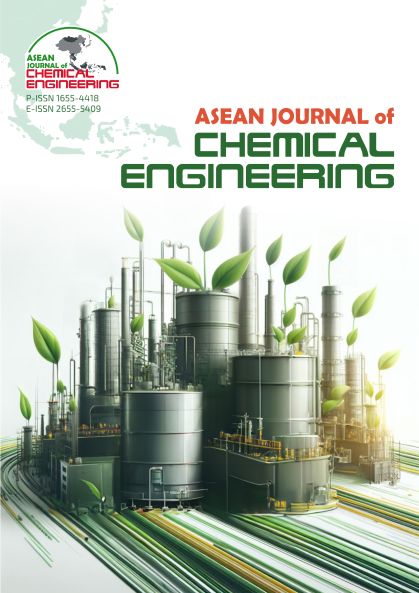Effect of Graphene Oxide Sealing on the Corrosion Resistance of Anodized Aluminum Oxide
Abstract
Aluminum alloy materials are widely used in aerospace, construction industry, automotive, and other fields due to their low cost and typical properties, including high strength-to-weight ratio and good corrosion resistance. The role of the anodization process that forms anodic aluminum oxide (AAO) can improve corrosion resistance, but the aluminum surface is pivoted after the anodization process. This study was conducted to determine the effect of GO-sealed on the corrosion resistance of AAO. The results show that anodized aluminum with GO-sealed performs better corrosion resistance as indicated by higher Rporous and Rsolid values when compared to unsealed anodized aluminum. Furthermore, anodized aluminum with GO-sealed has a smoother surface and harder than unsealed aluminum. It is indicated by surface characterization and hardness test.
References
Adyono, N., and Lestari, W.D., 2020. “Hard Anodize of 6061-T0 Aluminium Alloy in Sulfuric Acid Bath at Near Zero Temperature and Its Mechanical Properties,” in: 1st International Conference Eco-Innovation in Science, Engineering, and Technology. Galaxy Science, Surabaya, Indonesia.
Affi, J., Handayani, M., Anggoro, M.A., Esmawan, A., Sabarman, H., Satriawan, A., Shalannanda, W., Siburian, R., and Anshori, I., 2023. “Electrochemical and capacitive behavior of reduced graphene oxide from green reduction of graphene oxide by urea for supercapacitor electrodes.” J. Mater. Sci.: Mater. Electron. 34, 1–11.
Badr, A., Sadighi, M., Asgharzadeh, H., and Rabizadeh, T., 2019. “Enhancing the corrosion resistance of aluminum by graphene oxide and reduced graphene oxide films.” Mater. Res. Express 6, 075606.
Caporali, S., Fossati, A., and Bardi, U., 2010. “Oxidative post-treatments for enhanced corrosion resistance of aluminium electrodeposited from ionic liquids.” Corros. Sci. 52, 235–241.
Handayani, M., Kepakisan, K.A.A., Anshori, I., Darsono, N., and Nugraha T., Y., 2021. “Graphene oxide based nanocomposite modified screen printed carbon electrode for qualitative cefixime detection.” AIP Conf Proc 2382.
Handayani, M., Suwaji, B.I., Ihsantia Ning Asih, G., Kusumaningsih, T., Kusumastuti, Y., Rochmadi, and Anshori, I., 2022. “In-situ synthesis of reduced graphene oxide/silver nanoparticles (rGO/AgNPs) nanocomposites for high loading capacity of acetylsalicylic acid.” Nanocomposites 8, 74–80.
Hu, N., Dong, X., He, X., Browning, J.F., and Schaefer, D.W., 2015a. “Effect of sealing on the morphology of anodized aluminum oxide.” Corros. Sci. 97, 17–24.
Kang, D., Kwon, J.Y., Cho, H., Sim, J.H., Hwang, H.S., Kim, C.S., Kim, Y.J., Ruoff, R.S., and Shin, H.S., 2012. “Oxidation resistance of iron and copper foils coated with reduced graphene oxide multilayers.” ACS Nano 6, 7763–7769.
Li, Q., Liang, J., Liu, B., Peng, Z., and Wang, Q., 2014. “Effects of cathodic voltages on structure and wear resistance of plasma electrolytic oxidation coatings formed on aluminium alloy.” Appl. Surf. Sci. 297, 176–181.
Sherif, E.S.M., 2013. “Electrochemical investigations on the corrosion inhibition of aluminum by 3-amino-1,2,4-triazole-5-thiol in naturally aerated stagnant seawater.” J. Ind. Eng. Chem.19, 1884–1889.
Wisnujati, A., Wijayanto, H., Widodo, A.M., Mudjijana, and Rahaman, M., 2023. “Characterization of anodizing process on aluminum series 6 with variable voltage,” in: Proceedings of the First Mandalika International Multi-Conference on Science and Engineering 2022, MIMSE 2022 (Mechanical and Electrical). Atlantis Press International BV, pp. 46–56.
Xue, B., Yu, M., Liu, J., Li, S., Xiong, L., and Kong, X., 2016. “Corrosion protective properties of silane functionalized graphene oxide film on AA2024-T3 aluminum alloy.” J. Electrochem. Soc. 163, C798–C806.
Yu, M., Dong, H., Shi, H., Xiong, L., He, C., Liu, J., and Li, S., 2019. “Effects of graphene oxide-filled sol-gel sealing on the corrosion resistance and paint adhesion of anodized aluminum.” Appl. Surf. Sci., 479, 105–113.
Yu, X., Zhang, G., Zhang, Z., and Wang, Y., 2023. “Research on corrosion resistance of anodized and sealed 6061 aluminum alloy in 3.5 % sodium chloride solution.” Int. J. Electrochem. Sci., 18, 100092.
Zhang, J. sheng, Zhao, X. hui, Zuo, Y., and Xiong, J. ping, 2008. “The bonding strength and corrosion resistance of aluminum alloy by anodizing treatment in a phosphoric acid modified boric acid/sulfuric acid bath.” Surf. Coat. Technol. 202, 3149–3156.
Zuo, Y., Zhao, P.H., and Mao, J.M., 2003. “The influences of sealing methods on corrosion behavior of anodized aluminum alloys in NaCl solutions.” Surf. Coat. Technol. 166, 237–242.
Copyright (c) 2024 ASEAN Journal of Chemical Engineering

This work is licensed under a Creative Commons Attribution-NonCommercial 4.0 International License.
Copyright holder for articles is ASEAN Journal of Chemical Engineering. Articles published in ASEAN J. Chem. Eng. are distributed under a Creative Commons Attribution-NonCommercial 4.0 International (CC BY-NC 4.0) license.
Authors agree to transfer all copyright rights in and to the above work to the ASEAN Journal of Chemical Engineering Editorial Board so that the Editorial Board shall have the right to publish the work for non-profit use in any media or form. In return, authors retain: (1) all proprietary rights other than copyright; (2) re-use of all or part of the above paper in their other work; (3) right to reproduce or authorize others to reproduce the above paper for authors’ personal use or for company use if the source and the journal copyright notice is indicated, and if the reproduction is not made for the purpose of sale.



